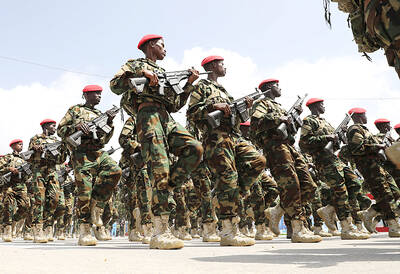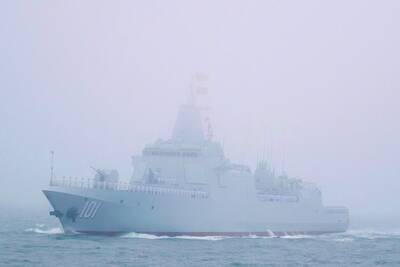Almost two months after the Asian tsunami swept away a passenger train, killing nearly 2,000 people, Sri Lanka prepared yesterday to send its first train along the repaired coastal tracks in a symbolic journey meant to show that life is returning to normal.
Engine 59 and the eight coaches of the Queen of the Sea have become an icon of the Dec. 26 tragedy that killed nearly 31,000 people on this island.
Yesterday's train left the capital, Colombo, for the port of Matara, about 120km south. After three hours, it reached the train disaster site at Peraliya village, where officials and dignitaries on board were set to attend a Buddhist ceremony honoring those who perished.
About a kilometer down the restored rail line, the train was to pass three battered, rust-colored coaches of the tsunami-hit train.
The coaches have been put back on parallel tracks, where they remain as a reminder of the killer waves. Entering them is prohibited.
Of the 2,000 victims, 824 bodies were found. Some were passengers, others were villagers who climbed onto the train in attempt to get above the water. Scores were buried in mass graves.
"It will be a site people will not forget for a very long time," said Priyal de Silva, the general manager of the state-run railways.
"We still can't believe how the sea managed to topple this train," said Bladina Perera, who traveled with her family and friends from a town north of Colombo to inspect the damage.
While many people looked forward to the resumed rail services, for some the memory of the tragedy was too fresh.
The station manager, Nimal Premasiri, was on the train with his family when the waves struck. He lost his wife and 18-year-old daughter.
"I'm not sure when I will be ready to go," he told reporters. "I feel a terrible sense of loss and emptiness ... hard to explain. It was on a Sunday like this that we set off. We were so happy."
The train had been chugging slowly up the sandy, palm-fringed coast and was at Peraliya, near the historic city of Galle, when the waves struck, twisting the engine.
Yesterday, workers with shovels and other tools were frantically putting the final touches on the new tracks. "This is a special train to inaugurate and test the track," de Silva said.
Regular service won't resume yet, he said, adding the signaling system and the track were still not up to pre-tsunami standards. Some of the signaling between stations will be done manually, he said.

ELECTION DISTRACTION? When attention shifted away from the fight against the militants to politics, losses and setbacks in the battlefield increased, an analyst said Recent clashes in Somalia’s semi-autonomous Jubaland region are alarming experts, exposing cracks in the country’s federal system and creating an opening for militant group al-Shabaab to gain ground. Following years of conflict, Somalia is a loose federation of five semi-autonomous member states — Puntland, Jubaland, Galmudug, Hirshabelle and South West — that maintain often fractious relations with the central government in the capital, Mogadishu. However, ahead of elections next year, Somalia has sought to assert control over its member states, which security analysts said has created gaps for al-Shabaab infiltration. Last week, two Somalian soldiers were killed in clashes between pro-government forces and

Ten cheetah cubs held in captivity since birth and destined for international wildlife trade markets have been rescued in Somaliland, a breakaway region of Somalia. They were all in stable condition despite all of them having been undernourished and limping due to being tied in captivity for months, said Laurie Marker, founder of the Cheetah Conservation Fund, which is caring for the cubs. One eight-month-old cub was unable to walk after been tied up for six months, while a five-month-old was “very malnourished [a bag of bones], with sores all over her body and full of botfly maggots which are under the

BRUSHED OFF: An ambassador to Australia previously said that Beijing does not see a reason to apologize for its naval exercises and military maneuvers in international areas China set off alarm bells in New Zealand when it dispatched powerful warships on unprecedented missions in the South Pacific without explanation, military documents showed. Beijing has spent years expanding its reach in the southern Pacific Ocean, courting island nations with new hospitals, freshly paved roads and generous offers of climate aid. However, these diplomatic efforts have increasingly been accompanied by more overt displays of military power. Three Chinese warships sailed the Tasman Sea between Australia and New Zealand in February, the first time such a task group had been sighted in those waters. “We have never seen vessels with this capability

‘NO INTEGRITY’: The chief judge expressed concern over how the sentence would be perceived given that military detention is believed to be easier than civilian prison A military court yesterday sentenced a New Zealand soldier to two years’ detention for attempting to spy for a foreign power. The soldier, whose name has been suppressed, admitted to attempted espionage, accessing a computer system for a dishonest purpose and knowingly possessing an objectionable publication. He was ordered into military detention at Burnham Military Camp near Christchurch and would be dismissed from the New Zealand Defence Force at the end of his sentence. His admission and its acceptance by the court marked the first spying conviction in New Zealand’s history. The soldier would be paid at half his previous rate until his dismissal